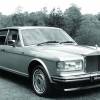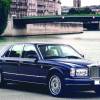
RAC sale – up to 33% off*
• Roadside cover from £5.29 a month†
• We get to most breakdowns in 60 mins or less
• Our patrols fix 4/5 breakdowns on the spot

By Jonathan Crouch
Introduction
The seventh generation Rolls-Royce Phantom was the car that back in 2003 re-launched its brand under BMW ownership in inimitable style. It's a super-luxury saloon that still commands the road like no other car on Earth. Massive in every respect and full of cutting-edge technology, it combines British craftsmanship with BMW engineering know-how.
Models
4dr Luxury Saloon (6.75-litre V12 petrol)
History
Engineer Charles Stewart Rolls and car dealer Henry Royce joined forces back in 1904 with the aim of producing the very best automobiles in the world. Film stars, statesmen and dignitaries the world over testify that they still do. These people care little that today, the company is no longer British-owned, nor do its products now hail from the traditional Pyms Lane factory in Crewe. Excellence is all that matters and since the turn of the century, this classic brand has begun afresh in a new quest to achieve it, the first design of its new era launched in 2003 - this seventh generation Phantom saloon.
It remained British-built, fashioned in a state-of-the-art manufacturing plant in Goodwood, though with bodywork fabricated and engines provided by BMW. And as expected, blended advanced technology and traditional hand-craftsmanship - with extraordinary results. As a used car, this model still represents the world's ultimate automotive status symbol amongst luxury cars from its era. A long wheelbase 'EWB' body shape was introduced as an option in 2015. The MK VII Phantom It sold until the eighth generation Phantom model was launched in late 2017.
What You Get
Nobody could accuse this Rolls Royce of looking ordinary and, if you like to keep a low profile, then you'd be better off plumping for something more discreet like a Maybach. The MK VII Phantom was designed and modelled in London - at a converted bank opposite Hyde Park that used to be Johnny Depp's UK apartment - and still creates visual shockwaves years after it was first unveiled. Apparently the design team worked out that a car's height should be twice that of its wheels and the resulting proportions are enormous. But it works, thanks to a fuss-free profile and a nose that blends classic Rolls-Royce tradition with controversial aspects like the way the headlamps are integrated.
Open the driver's door and you're greeted with one of the finest car interiors in history. Build quality is of course exemplary with cutting edge technology, but there's none of the confusing gadgetry found in, say, a BMW 7-Series from this era. In a Phantom, any controls not needed for everyday driving are kept out of sight until required. The doors are helped to fasten shut by silent hydraulic motors that seal you from the outside world. It's an oasis of calm inside, with every possible luxury at your disposal. In fact it's such a glorious place to reside that you'll be tempted to move in - something you have every right to expect after spending the kind of money that might otherwise go a long way towards securing you a nice riverside apartment.
The sumptuous interior is crafted from the finest leather and timbers available. The switches for the power windows and audio system are beautifully crafted 'violin keys', while the chrome air vents are operated by traditional 'organ stops'. At least 15 hand-stitched hides go into the 450 individual leather parts that cover the various surfaces and each of the 43 different wooden sections are made up from up to 28 individual layers. This is luxury on an altogether different level and everything looks just so touchable you can't help but run your fingers over every tactile surface.
Hinged at the back rather than the front, the rear coach doors allow back seat passengers to enter and exit gracefully and can be closed at the press of a button. Once inside, original buyers had a choice of specifying either individual chairs separated by a centre console or a rear 'lounge seat' which features curved outer edges, making it easy to turn and face a fellow passenger. Either way, the base is elevated by 18mm for a peerless view ahead and situated behind the rear C-pillar for safety as well as privacy from aspiring paparazzi.
Legroom is ample - and of course even better if you can afford to pay the premium for the 'EWB' extended wheelbase version with its extra 250mm of rear compartment length. This enables the provision of things like a partition wall for privacy, drinks cabinets in the rear doors, rear window curtains or even a safe in the 460-litre boot. This model really is huge - indeed you could fit a new Fiat 500 between its front and rear wheels with room to spare. But then, at this end of the luxury car market, size definitely matters.
What You Pay
Please fill in the form here for an exact up-to-date information.
What to Look For
You wouldn't expect much to go wrong on a car of this calibre - and apparently, not much does. Look out for radiator leaks on pre-2008 models that have covered more than 50,000 miles. Experts will also tell you to inspect the seals at the ends of the coolant pipe that lies in the 'V' of the engine's cylinders and runs from the water pump to the block. Plus, they say, check for oil leaks from the rocker cover gaskets. And listen for poor running tickover on earlier models that could be caused by failing injectors.
Remember that the Phantom has two batteries and regular short journeys can deplete them, so give them a check over. On this hefty car, the suspension ball joint bushes can wear quickly, so they're worth a check. There are reports of the air suspension system in some models developing leaks, which in turn puts a strain on the pumps, causing them to eventually fail. The brakes will have been well used, so check the pads and discs. Rolls Royce issued a recall in October 2010 for cars built between 2003 and 2009 regarding a possible reduction in brake servo assistance; check that the owner of the car you're looking at responded to this, if appropriate. Inside, things should be pristine, but the plastic trims on the sear base can get dislodged and broken by rear passengers as they exit; replacements are available. Otherwise, just check he usual things - scratches on the expensive alloys, blemishes on the leather trim and so on. Insist of course on a full service history.
Replacement Parts
(approx based on a 2010 Phantom) An air filter is around £21, an oil filter is around £15. A headlamp bulb is around £75. Rear brake pads will be about £40 for a set. A thermostat is around £115, while a starter motor is around £495.
On the Road
When BMW set about designing an all new Rolls-Royce, there was a very real danger that the Phantom would end up as nothing more than a super luxurious 7-Series in disguise. But that didn't happen and the result was a new car in every sense of the word, the German brand resisting the temptation to use anything from the floorpan, suspension or cabin of any of its existing models.
What was transferred over intact was BMW's 'Ultimate Driving Machine' expertise, with the result that the Phantom is as much a joy behind the wheel as it is to ride in the rear. That most owners, relaxing in the back with a copy of the FT, will never know this is a pity. It's their loss, for the experience you get up-front, perched high and SUV-like, clasping the beautifully crafted thin-rimmed steering wheel, is a unique one.
Power, something the Rolls-Royce of old would simply state was 'sufficient', is rated at 453bhp from a 6.75-litre V12 normally aspirated engine you'd be forgiven for thinking wasn't even there it's so silent. An awesome 720Nm of torque means that sixty is as little as 5.5s away on the way to 150mph but you're never in any doubt that shifting two and a half tonnes of automotive real estate at Porsche Boxster speeds is of little consequence to this engine. At 100mph, the power reserve gauge that replaces the usual rev counter indicates that around 90% of power remains untapped.
It's obviously not a car to be driven sideways on a race track but classic BMW 50:50 weight distribution, accurately responsive steering and a spaceframe boasting the rigidity of a Formula 1 racing car mean you can actually throw the thing around with impunity if the situation calls for it - just ask any chauffeur who's been trained in the art of evasive driving in one of these. On really tight roads of course, you do have to allow for its sheer physical size but even here, this remains a dynamic and focussed car, the advanced air-sprung suspension preventing the cornering roll expected from previous Rolls-Royces.
But we digress. What's really relevant of course is how this car feels to ride in. And you probably don't need us to tell you that it feels exquisite, the last word in comfort, refinement and luxury. You waft silently over even the most seriously potholed surfaces as though they weren't there. And though there are only six speeds to the ZF automatic transmission where more modern luxury cars would have seven or eight, it's still silky-smooth, the ratios always in the right place at the right time.
Overall
So, was this MK VII Phantom a glorious irrelevance or the world's finest motorcar? Or maybe, just maybe, a bit of both. It's certainly hard to think of another means of transport from this era that offers luxury, elegance and style on this level. In one of these, a journey isn't something you undertake merely to get somewhere you'd rather be: getting there becomes part of the pleasure.
The way the designers of this car tapped into such a deep vein of tradition and history is as impressive as the care taken in its construction. It took at least 460 hours to hand-build one of these before the five layers of paint and clear lacquer were hand-polished for five hours. The result is a cut above the rest - a car that Charles Rolls and Henry Royce would be proud of.







